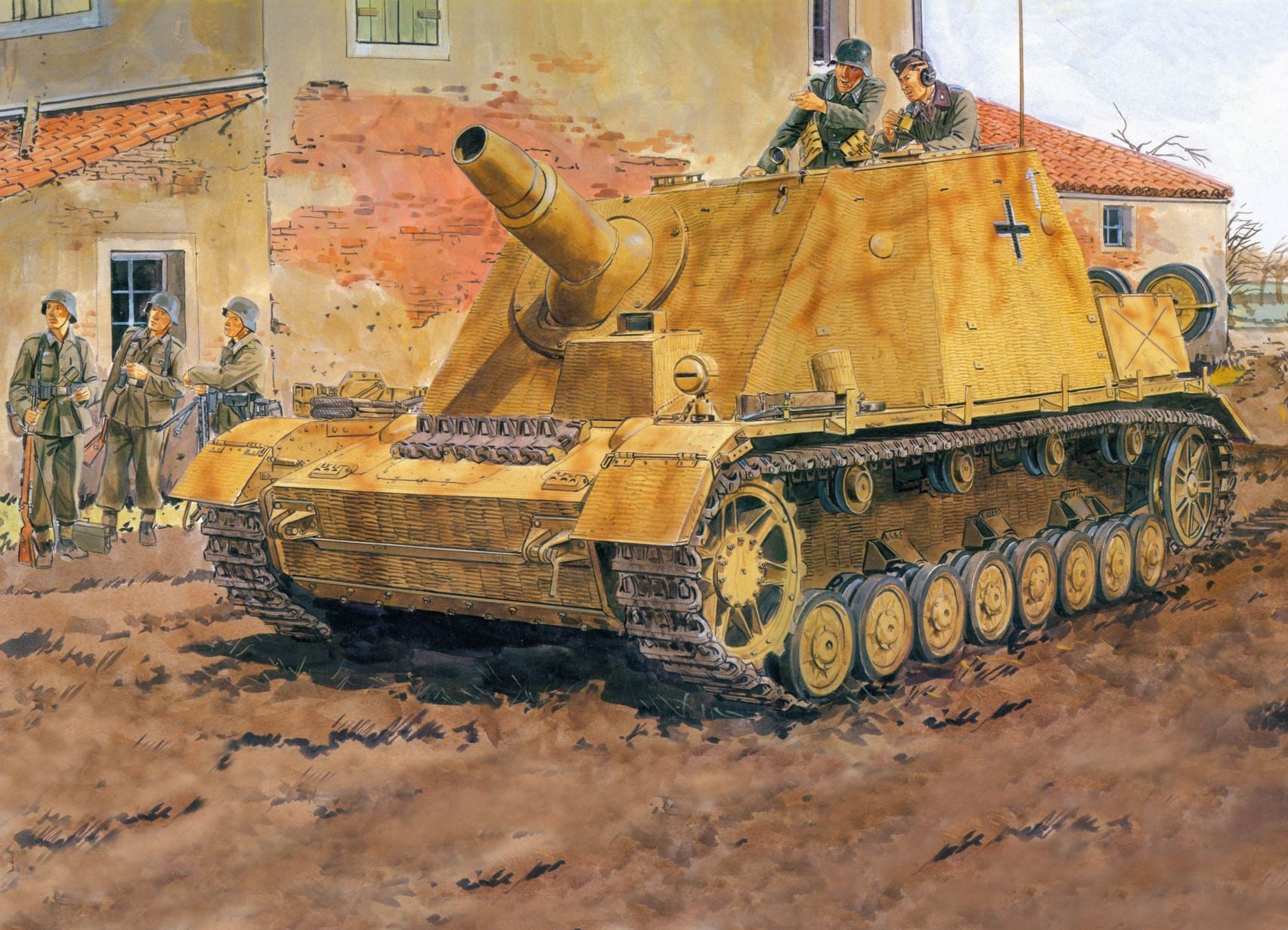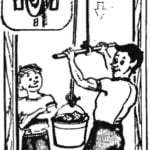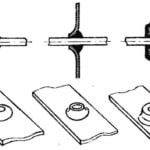 Classification of self-propelled artillery of the Wehrmacht were quite complex and confusing. There were several main classes of ACS: Sturmgeschütze — assault guns, Selbstfahrlafetten — self-propelled carriages, . und Jagdpanzer self — propelled anti-tank guns, anti-tank, Flakpanzer — anti-aircraft self-propelled guns. The confusion in classification is exacerbated by the fact that the machines belong to one type when upgrading actually acquired the characteristic features of the other. For example, the assault gun StuG III after the re-75-mm long-barreled gun turned into a classic tank destroyer — Jagdpanzer, and in this capacity was used, although up to the end of the war was still called an assault weapon.
Classification of self-propelled artillery of the Wehrmacht were quite complex and confusing. There were several main classes of ACS: Sturmgeschütze — assault guns, Selbstfahrlafetten — self-propelled carriages, . und Jagdpanzer self — propelled anti-tank guns, anti-tank, Flakpanzer — anti-aircraft self-propelled guns. The confusion in classification is exacerbated by the fact that the machines belong to one type when upgrading actually acquired the characteristic features of the other. For example, the assault gun StuG III after the re-75-mm long-barreled gun turned into a classic tank destroyer — Jagdpanzer, and in this capacity was used, although up to the end of the war was still called an assault weapon.
Among this diversity there was also the class of so-called “assault tanks” (Sturmpanzer). The tanks, however, were part of his military machine nothing had. Most self-propelled guns listed as assault tanks armed with 150-mm heavy infantry gun sIG 33. However, some of the machines created for the terms of reference for the assault tanks, never been ranked, and, on the contrary, the specified tool is armed with not only assault tanks.
For example, the first ACS, which was installed 150-mm infantry gun was self-propelled gun on the chassis of tank Pz.l. This car in General can be seen as the first serial German self-propelled installation.
Demonstration of a prototype self-propelled guns and ammunition carrier (on the self-propelled ammunition is not transported) to the command of the Wehrmacht was on the 29th of January 1940, which was followed by an order for 38 cars.
Heavy 150-mm infantry gun sIG 33 (sIG — schwere’infanterie Geschütz) with a barrel length of 11.4 caliber, developed by Krupp in 1927, was installed on the roof of the hull of the Pz.l together with gun carriage and wheels. To protect the guns from three sides were built of bulky turret welded from 10-mm armor plates. The height of the car has exceeded 3 m, and the weight rose to 8.5 t, as the gun itself combat ready weighed 1750 lbs. And both the negative impact on patency. In addition, high and narrow SAU had a tendency to tip over. However, this car is well met in the army. The fact that slG 33 was in service Roth infantry guns in the infantry regiments of the Wehrmacht in 1933 and was well known to the German gunners. But in the towed variant, the gun was too heavy, so that the soldiers could not welcome the appearance of his self-propelled version.
In part 701 — 706 th mouth heavy infantry guns these cars took part in the fighting in France and the Balkans, and then on the Eastern front. In the fall of 1943, one destroyer of this type was still in service 704 companies of heavy infantry guns.
The first self-propelled installation created as a assault tank, though not quite in charge of the tactical and technical requirements of the latter (in accordance with their military machine had to be fully armored), was ACS on the basis of a light tank Pz.ll.
In February 1941, the factory FAMO produced based on the tank Pz.ll Ausf.B a prototype self-propelled artillery unit armed with a heavy infantry gun sIG 33. When this chassis was borrowed without any changes, so the fighting compartment ACS was too tight.

Brummbär assault tank 1-series:
1 — 150-mm howitzer; 2 plug the loopholes for firing personal weapons; 3 — bracket side screen; 4 — Luke loader; 5 — the blind cover to install the periscopic sight; 6 — the gunner’s hatch; 7 – hatch commander’s; 8 — drawer for equipment; 9 — armor fan shroud; 10 — spare support roller. The types of side, top and front of anti shaped-charge side shields conventionally not shown
In mass-produced cars, the body was extended to 330 and extended by 600 mm In suspension said one support roller on Board. In this form the car was taken by the Wehrmacht under the designation 15 cm sIG 33 auf Pz.Kpfw.ll or Sturmpanzer II.
Heavy 150-mm infantry howitzer (the swinging part of the top of the machine) were installed in front of the open low-profile deckhouse. Combat weight of the machine was 12 so the Maximum speed reached 40 km/h, cruising on the highway is 140 km. Combat tower was welded together from armor plates with a thickness of 15 mm. as additional weapons in the car was placed a machine gun MG 34.
Mass production of the ACS began in late 1941 at the firm Alkett. However, it was made only 12 units (7 — in 1941 and 5 in 1942), which formed 707 th and 708 th company of heavy infantry guns. Both companies were sent to North Africa where they participated in the fighting, including the battle of El Alamein. Last Sturmpanzer II was captured by the Western allies during the surrender of German forces in the spring of 1943 in Tunisia.
The initiator of the next assault tank was the famous German designer Dr. Ferdinand Porsche, who served until 1944 the post of Chairman of the tank Board and the Ministry of armaments. He proposed to use as a base for SAU 150-mm infantry gun medium tank chassis Pz.III, is much more suited for this purpose than the Pz.ll and, especially, Pz.l.
In the winter of 1941/42 the Berlin firm Alkett produced a prototype of such ACS. With a combat weight of 21 tons machine has a fully armoured cabin a simple form with a front armor of 50 mm, reinforced subsequently to 80 mm patch plates. In the embrasure of a frontal leaf cuttings were set swinging part of the 150-mm gun sIG 33. To the right of it in the regular tank ball mount Kugelblende 50 set exchange machine gun MG 34. In the top of the cabin there was a hatch for the landing of the crew and the recess for the output periscopic sight.

The contract concluded with the firm Alkett, provided for the production in 1942, 12 self-propelled guns, called Sturminfanteriegeschütz 33 (StuIG 33) or Sturmpanzer 33). StuIG 33 was used in Stalingrad in part 177 th attack division. Their 150-mm shells more than any other came to shooting the walls of buildings, invulnerable to guns of smaller caliber. Fully armored corps ACS protected the crew from bullets and shrapnel.
In September 1942, the hastily began production of 12 combat vehicles of this type. However, in Stalingrad they do not fall and in the spring of 1943 all were included in the assault battery of heavy infantry guns of the 17th training battalion. Fighting vehicles, which participated in the fighting in Stalingrad, was destroyed by the red Army, a part captured. As for assault battery, after losing five ACS it was disbanded. The remaining seven StuIG 33 in the summer of 1943 he transferred to the 23rd Panzer division. Up to the present day survived only one fighting machine of this type. She is in the Military historical Museum of armored vehicles and armament in Kubinka.
In November 1942, the Minister of armaments of the Third Reich A. Speer introduced to Hitler the sketches of the new machine, the development of which began firm Alkett. This time the basic design was laid medium tank chassis Pz.IV. Hitler demanded in the shortest terms to make 40-60 of these ACS, armed with an advanced weapon with a more powerful explosive shell — the fighting in Stalingrad was in full swing.
Since the power tank factories were loaded to the limit and admission of newly manufactured chassis in large quantities did not have to wait, for the manufacture of the ACS decided to use the chassis of fighting vehicles arriving for overhaul. As for the new guns, the order for its development and manufacture was received by the firm Skoda.
Ballistics of the new cannon was borrowed from the sIG 33. Newly developed recoil device and the mask-a setting that allowed to reduce its dimensions, weight and kickback while maintaining all other performance characteristics.
The gun was designated the 15 cm Sturmhaubitze 43. Barrel length was 1810 mm, weight of the gun — 1850 kg. ammunition consisted of rounds of separate loading ammunition with high-explosive shells JGr JGr 33 and 38 with 38 kg mass and an initial velocity of 240 m/s and with shells Gr 39 H1/A mass of 25 kg and an initial velocity of 280 m/s, opening 160 mm of armor. Maximum firing range of the assault howitzers was up to 4300 m. due to the mounting of the gun in a ball mount traverse was 18° to the side, vertical — from -8° to +30°.
The first six guns, Skoda manufactured in March, following a 40 — in April and last 14 in may. Respectively, were issued and 60 ACS, 20 in April and 40 in may 1943. For 52 of these were newly manufactured factory the Nibelungenwerk tank chassis Pz.IV Ausf.G, for the other chassis received a repair of tanks Pz.IV Ausf.E and Ausf.F. Assembly of self-propelled guns, which received the official name of the Sturmpanzer IV, was carried out in the repair plant of the army in Vienna with the participation of firms Saurer and Simmering-Graz-Pauker. For the first time new combat vehicle was demonstrated to Hitler on 15 may 1943 on the training ground Arys.
All the Sturmpanzer IV had a fully armored combat cabin located under a large angle of inclination 100-mm frontal plate. The combat weight of the machine is made up of 28.2 tons (23.5 t against the base of the tank). Despite some overloading of the chassis and power plant, maximum speed was 40 km/h and power reserve is 180 km away.
All 60 “sturmpanzer” the first series was sent to the newly formed 216-battalion assault tanks (Sturmpanzer-Abteilung 216). Baptism of fire, the battalion received on the Eastern front during operation Citadel in summer 1943. “Vehicles” is quite effectively used for the destruction of fortifications in the breakout line of defense of the Soviet troops. Therefore, it was decided to resume their production with the pace of the Assembly 20 cars a month.

The release of the ACS began again in December 1943. As a base was used the chassis of a medium tank Pz.IV, modification H. The design and shape of the cabin was a small change. In particular, increased rubocki driver was liquidated borrowed from the tank “Tiger” surveillance device the fahrersehklappe 80, but instead is mounted periscope. In addition, from February 1944 in combat vehicles began to set the instrument 15 cm Sturmhaubitze 43/1 long shutter barrel shroud. The number and location of ventilators and hatches on the coach roof. In all there were 73 Sturmpanzer IV the so-called second or middle series. By the way, in 1944 fighting vehicle has received the unofficial name Brummbär (“Brummbar” — “Grizzly”), which is known for much more than its official designation.
From July 1944 began production of the third, or late-series self-propelled guns, which lasted until March 1945. Now as a base was used the chassis of the Pz.IV Ausf.J. In addition, much has been redone combat tower. Previously used hexagonal shape with beveled frontal “cheeks” was replaced with a more simple quadrangular. In front of the compartment above the cabin of the driver in the ball mount Kugelblende 80 has been mounted MG 34 machine gun. On equip “Brummbar” defensive gun long insisted the troops. On the roof of the wheelhouse again changed the number and shape of the ventilators and hatches. Appeared commander’s cupola borrowed from the assault gun StuG III Ausf.G. Double doors aft of the deckhouse is now located shifted to the left side of the tank’s ledge.
Markedly changed and suspension. Machines of the first two series had rubber rollers. Due to overload rubber tires was falling fast, which led to the exit of the ACS failure. Therefore, “brummbar” third series began to install track rollers with steel rims. First they replaced the rubber only in the first truck suspension, then the two front. Most of the “brumbelow” late edition all track rollers undercarriage had steel rims. However, the use of such rollers accelerated wear of the tracks, but he was not as fast as the destruction of the rubber.
According to various sources, up to March 1945 was made 298-306 Brummbär assault tanks.
At the end of 1943, in addition to the 216-mu formed 217th, 218th and 219th battalions of assault tanks, each of which had 45 combat vehicles.
“Brummbar” fought on the Eastern front, in Italy, Anzio and Nettuno, and on the Western front. The last major operations in which these machines had a chance to play the role of assault tanks, began an offensive in the Ardennes in December 1944 counterattack in the area of lake Balaton in January — March 1945. At the beginning of March 1945 the Wehrmacht still had 188 Brummbär assault tanks.
M. KNYAZEV



